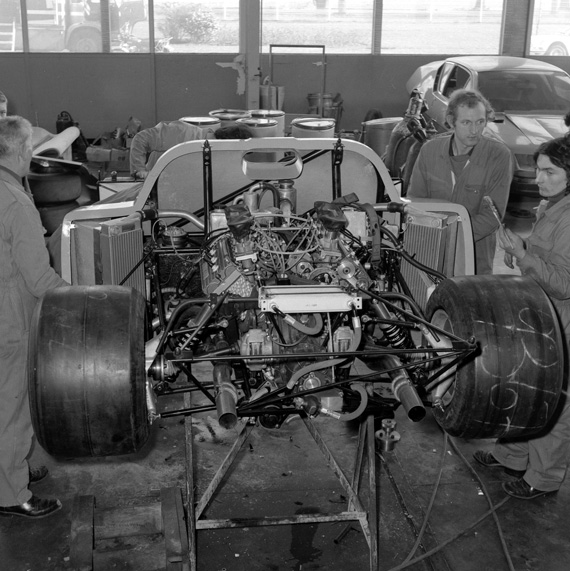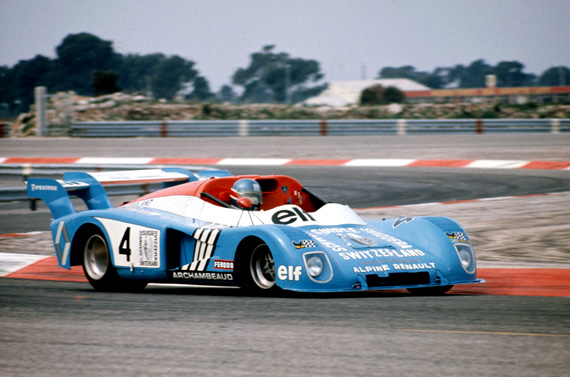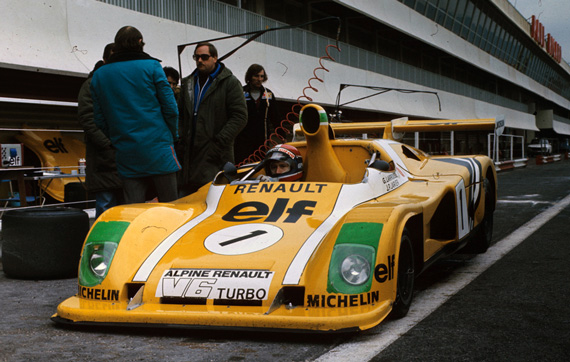Text by Roberto Motta
Photos: Renault Internal Archive / Press
While Roy Smith provided an interesting history on one specific Alpine A-441, (read story), Roberto Motta traces the development of the Renault Alpine Gordini A440 and 441 two liter endurance cars designed for the hotly contested 1971 2 liter European Championship and the 2 liter category of the World Sports Prototype Manufacturers’ Championship.
In ’71 the Alpine A110 had won the Monte Carlo Rally and the Alpine F3 successes proved that they could beat the British manufacturers. Alpine Renault decided to participate in endurance racing and to compete in the European Championship Sports 2000. But what was needed was a new engine that could power the Alpines.
The new 2 liter European Championship series met with great interest at both Renault and Elf and caught the attentions of Jean Claude Terrarmorsi and Claude Haardt, responsible respectively for competitions and Renault engines. Renault did not have a great deal of trust in the Alpine venture and were already involved in managing the Gordini works.
The new 2 liter European Championship series met with great interest at both Renault and Elf and caught the attention of Jean Claude Terrarmorsi and Claude Haardt, responsible respectively for competitions and Renault engines. Renault did not have a great deal of trust in the Alpine venture and were already involved in managing the Gordini works.
In April 1972, in the offices of Renault Gordini-in Viry-Châtillon, the first studies of the new V6 engine under Renault control began. The project kicked off under the direction of Georges Sauvan while the responsibility for the engine was given to Francois Castainge and Jean-Pierre Boudy. At the same time, in Dieppe, Bernard Dudot drew all the accessories required for the operation of the engine.
The new V6 Renault-Gordini was tested in November ’72 and was capable of delivering 270 hp. On 15 January ’73, the new engine built in the workshops of Viry-Châtillon was presented to the press under the name ‘type CH1’, which stood for Claude Haardt, who died in a car accident a few months prior to the completion of the engine. Immediately after the presentation, the engine was mounted on the Alpine Renault A440 which was to take part in some races of the French and of the European Championship Sports 2000 of 1973.
Designed by André de Cortanze, the A440 had a traditional tubular frame, side-mounted radiators and roll bar fairing, a feature that gave the rear lid a curved and sloping line.
Technically, the A440 featured wishbone front suspension and rear suspension had lower triangles formed by two parallel arms and triangles above wishbones. The transmission was a Hewland FT 200 5-speed + reverse.
January ’73 was a turning point for the Renault acquires control of 55% of Alpine.The competition department at Viry-Châtillon was then transferred to Dieppe; Jaques Cheinisse became the general manager of the new structure is called ‘Renault Sport’.
The management and organization addressed these changes while the A440 faced the first test in the hands of Jean-Pierre Jabouille, on the track of Dijon-Prenois.
The A440-0 made its debut race at Magny-Cours on May 5, where it garnered a fourth position driven by Jean Pierre Jabuille.
Three weeks later, on May 27, the A440-0 Jabuille won his first victory in Croix-en-Ternois in the region of Pas de Calais in northern France.
In the months following the A440-0 took part in competitions at Imola, Clermont-Ferrand, Nürburgring and Nogaro race in where it was joined by the A440-1 handled by Alain Serpaggi. Despite the initial successes, the A440 was suffering from poor reliability including chronic understeer, steering and suspension problems, aerodynamics, as well as ignition troubles. The combination of all these defects convinced the engineers to redesign the car, change the frame and some parts of the engine.
The entire project was then reviewed in the course of the winter ’73-’74, and led to the creation of the engine type CH1B and the new A441. The A441 debuted on 7 April 7 1974 in the ‘Trophée Paul Ricard’. There were two A441s, the A441-0 by Jean-Pierre Jabouille, and the A441-1 for Alain Cudini . The old A440-1 was driven by Gérard Larrousse. For the Renault, it was a good race. The 441-0 of Cudini won, while the A441-1 finished the race in 5th place and the A440-1 in 14th place.
In subsequent races the A441-0 continued to be driven by Alain Serpaggi, the A441-1 by Gérard Larrousse and A441-2 by Jean-Pierre Jabouille. After a long series of races in which the French car had no rival, the A441 won the European Championship – Sport-2000 and Alain Serpaggi won the drivers’ championship with 80 points ahead of Gérard Larrousse (80 points) and Jean-Pierre Jabouille (70 points).
After the triumphant ’74 season, the Alpine Renault diverted its efforts in the development of the turbocharged engine. The A441-1 was then updated to accommodate the new engine and turbo, and on 23 March 1975, participated in the 1000 km of Mugello, the second race of the World Sportscar Championship. Jean-Pierre Jabouille and Gérard Larrousse, started from the second position on the grid and won the victory ahead of the Alfa Romeo 33TT12 of Arturo Merzario and Jacky Ickx and the 908/3-011 Porsche turbo Herbert Muller and Gijs van Lennep. The all-girl team of Marie-Claude Beaumont and Lella Lombardi, entered by” Team Elf-Switzerland ‘, achieved good results in the World Sports Car Championship with the A441-3 (see story).
In the course of three seasons (’73-75) the fabulous French V6 participated in 23 races in the ‘Sport Prototype 2000’ returning 14 wins, 8 podiums and two pole positions.







Anyone ready with a checkbook to pick up on the evolution of the automobile, let’s talk.